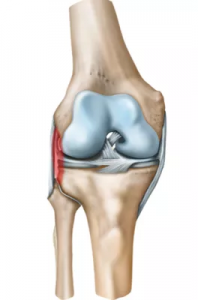LCL (lateral collateral ligament) injury

The LCL (Lateral Collateral Ligament) runs down the outside of the knee joint and supports the lateral aspect of the knee. It can be sprained (over stretched) or ruptured by a blow to the inside of the knee forcing the knee to buckle outwards, or by a player falling across the knee.
At the time of injury pain is felt along the outside of the knee. There may be a tearing felt or heard. The knee will swell slowly and it will be painful to continue play. Depending on the severity you may have difficulty walking and the knee may feel unstable.
If you think you have this injury you should get it checked out by Dr. Amit. It is best to stop sports to prevent further damage. It is important to treat the early phase with rest, ice, compression and elevation in order to minimise the bleeding and swelling. You should avoid any activities that lead to giving way, because each time this happens there can be further damage to the knee.
Treatment involves first confirming the diagnosis and establishing whether any other structures are damaged. This usually means a careful examination and an MRI scan. There can be meniscal tears and even fractures in association with an LCL rupture. Most LCL sprains will heal on their own with carefully directed program of rest, splinting and physio. Severe cases may need surgery. If treated properly from the beginning long-term damage can be minimised. Good physiotherapy should help prevent recurrence.
